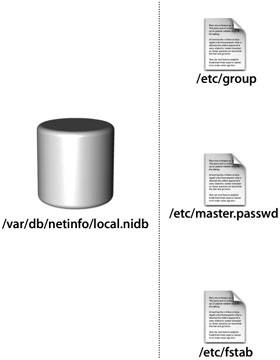Understanding Local Data Stores
| Open Directory in Mac OS X and Mac OS X Server provides system-level support for directory services as well as an extensible plug-in architecture that allows access to different data stores or other directory services. Like any directory service, it provides a standardized way for applications to request and receive information. Open Directory provides access to two local data storesNetInfo and BSD flat files. NetInfoThe NetInfo database is a repository for administrative information and is the default local data store in Mac OS X. It stores information that was traditionally found in configuration files in UNIX and some Apple-specific information, including the records for local users and groups, mount records, and possibly managed client settings. Some services that run on Mac OS X also use the local NetInfo database to store configuration information. For example, the Internet sharing feature (enabled in System Preferences) stores the Dynamic Host Configuration Protocol (DHCP) subnet information in the local NetInfo database. The NetInfo database is accessed through the netinfod process. Note Regardless of how you have configured directory services to search for data, the local NetInfo database is always searched first. This figure shows how traditional UNIX directory data was stored in several files (on the right) and how Mac OS X stores the data in the local NetInfo database (on the left). BSD Flat FilesIn Mac OS X version 10.2 and later, directory services can also retrieve administrative data from Berkeley System Distribution's version of UNIX (BDS) configuration files, or flat files. This capability enables organizations that already have flat files to use copies of those existing files on Mac OS X computers. BDS flat files can be used alone or in conjunction with other directory services. Mac OS X v10.2 also allowed you to use any BDS flat files and to customize the mappings of the attributes. Mac OS X v10.3 and later uses a fixed set of flat files. As such, no custom mapping of contents to Mac OS X record types or attributes is allowed. Because NetInfo and flat files are the only two local data stores, inserting flat files into the directory services data path can be used to show how directory services can access more than one source of administration information. BDS flat files should not be used as a replacement for local directory services; however, in some cases they are used to augment the local NetInfo database by allowing users to log in who are missing from the local NetInfo database. The following table lists the BDS configuration flat files.
You can edit the content of the flat files using any standard text editor. Locating Standard UNIX Files Containing User and Group DataTo show that the BDS flat files still exist in Mac OS X and Mac OS X Server, follow these steps:
|
EAN: 2147483647
Pages: 258
- Challenging the Unpredictable: Changeable Order Management Systems
- Enterprise Application Integration: New Solutions for a Solved Problem or a Challenging Research Field?
- Data Mining for Business Process Reengineering
- Intrinsic and Contextual Data Quality: The Effect of Media and Personal Involvement
- Relevance and Micro-Relevance for the Professional as Determinants of IT-Diffusion and IT-Use in Healthcare
- Chapter II Information Search on the Internet: A Causal Model
- Chapter III Two Models of Online Patronage: Why Do Consumers Shop on the Internet?
- Chapter IX Extrinsic Plus Intrinsic Human Factors Influencing the Web Usage
- Chapter XI User Satisfaction with Web Portals: An Empirical Study
- Chapter XVII Internet Markets and E-Loyalty
